Live blogged, so please excuse typos and awkward wordkings.
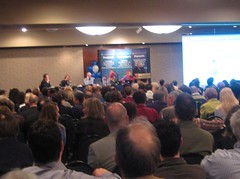 I’m sitting, at this moment, at the VSS conference in Vancouver, with the whole day to learn and converse. I’m a consumer today, Ian Jukes hits the stage in just a minute, but it was serendipitous to see Kevin McCluskey as I walked in. Kevin is with the New Brunswick DOE, and I’ve worked with him before in Fredericton — he’s traveled just about as far to be here as I have.
I’m sitting, at this moment, at the VSS conference in Vancouver, with the whole day to learn and converse. I’m a consumer today, Ian Jukes hits the stage in just a minute, but it was serendipitous to see Kevin McCluskey as I walked in. Kevin is with the New Brunswick DOE, and I’ve worked with him before in Fredericton — he’s traveled just about as far to be here as I have.
At breakfast, I sat with two educators who are DL (distributed learning) educators. They live about 300 Kilometers from Vancouver, and many of their students simply live too far away from any town to regularly attend class. So they have students using online curriculum, resources, and guidance — K-12.
 Watching a video now from the association, but no audio. Perfect. These folks understand 😉
Watching a video now from the association, but no audio. Perfect. These folks understand 😉
Ian Jukes is a master of visuals. He said it! These kids are “Digital Natives.” They speak digital as their first language. Again, as I’ve said so many times before, what worries me about the native/immigrants distinction is that some teachers may find this to be an excuse not to adopt the new information landscape. “I can’t learn this. I’m an immigrant.”
Jukes is make the point very well, though — leading into brain stuff. Our kids brains are different because of their information experience.
The very first thing to understand is that when we come into the world, only 50% of our brain wiring is done, that 50% is developed as a result of our experiences. I read something about this the other day, about plasticity, I think was the word. Over the last four years, we’ve found that almost everything that we thought we knew about the brain was wrong. We know that we can not change our memory capacities (this is good news). Ah! Neuro Plasticity. That’s the word. Wikipedia calls it Synaptic Plasticity.
Daniel Pink now, right versus the left. I’m seeing my keynote slides crumbling away 😉
So how do you reprogram your brain, “It takes several hours a day, seven days a week.” It’s what’s happening to kids. It’s “digital bombardment,” and it’s changing their brains.
Ian gives a minute of rest every eight minutes or so to share with each other what we’ve heard. This is very brain oriented activity. Some people are struggling with some of this stuff. Is this the first time that our brains have changed. I don’t think so. The difference is that now we know it.
Now he’s showing different MRIs of kids pathways compared to adult pathways, based on the same activity. Kids brains are wired differently. “Game play is reshaping our children’s brains.”
Jukes is sharing some very interesting information about reading, that we (oldsters) typical read in a “Z” pattern. Our youngsters read in an “F” pattern. You can read about this from info design guru, Jakob Nielson, F-Shaped Pattern for Reading Web Content.
Jukes is closing down now. The key question is, “How does this information affect how and what we teach?
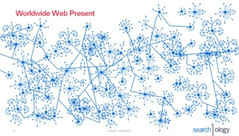 Ooops! I made the mistake of stealing one glance at my aggregator and found this (What is the future of “The World Wide Web?”) from Mark Kramer’s Smart Mobs. It seems that it was 15 years ago, today, that directors at the CERN lab (birthplace of WWW), signed a document proclaiming that the technology would be available to the world, free of charge. [image ((Prometheos, “Searchology-Web-Graph.” Prometheos’ Photostream. 7 Jun 2008. 30 Apr 2008 http://flickr.com/photos/23351126@N00/534201098/.))]
Ooops! I made the mistake of stealing one glance at my aggregator and found this (What is the future of “The World Wide Web?”) from Mark Kramer’s Smart Mobs. It seems that it was 15 years ago, today, that directors at the CERN lab (birthplace of WWW), signed a document proclaiming that the technology would be available to the world, free of charge. [image ((Prometheos, “Searchology-Web-Graph.” Prometheos’ Photostream. 7 Jun 2008. 30 Apr 2008 http://flickr.com/photos/23351126@N00/534201098/.))]
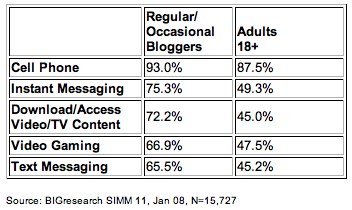 It was also interesting to see the fairly significant differences between regular and occassional bloggers’ use of New Media applications compared to the general (18+) population. The article labels the applications as “Top 5,” though I’m not sure what that means. See the table to the right.
It was also interesting to see the fairly significant differences between regular and occassional bloggers’ use of New Media applications compared to the general (18+) population. The article labels the applications as “Top 5,” though I’m not sure what that means. See the table to the right. Marlene Woo-Lun just forwarded to me a post from LM-Net (about 9 million librarians online), apparently posted by Donna (taglines) Baumbach, of University of Central Florida. ((Baumbach, Donna. “Web 2.0 Tools – Need Your Input.” E-mail to LM_NET Mailing List.25 Apr 2008.)) The message is thanking more than 600 LM-Net members (school librarians) who contributed information for a giant wiki site on Web 2.0 tools —
Marlene Woo-Lun just forwarded to me a post from LM-Net (about 9 million librarians online), apparently posted by Donna (taglines) Baumbach, of University of Central Florida. ((Baumbach, Donna. “Web 2.0 Tools – Need Your Input.” E-mail to LM_NET Mailing List.25 Apr 2008.)) The message is thanking more than 600 LM-Net members (school librarians) who contributed information for a giant wiki site on Web 2.0 tools — 
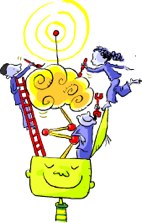 If this visual strikes your teacher-imagination, then you need to check out the
If this visual strikes your teacher-imagination, then you need to check out the 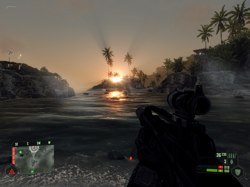
 Multiverse is working on a concept related to pear to pear sharing, where you can move easily from world to world with one avatar.
Multiverse is working on a concept related to pear to pear sharing, where you can move easily from world to world with one avatar.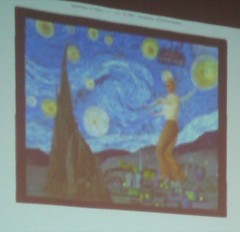 Now Mark is showing a video of a possible project a student might do about Van Gogh’s Stary Starry Night, with Don Mclain playing in the back ground. It’s a Machinima of the building of something. One wall, copied to another wall and another. Now various shapes are being made, but evidiently he’s put an affect on the video to make it look paint-brushed — amazing. It’s becoming a village — perhaps the villae from the painting. Trees are now being makde, and a back drop.
Now Mark is showing a video of a possible project a student might do about Van Gogh’s Stary Starry Night, with Don Mclain playing in the back ground. It’s a Machinima of the building of something. One wall, copied to another wall and another. Now various shapes are being made, but evidiently he’s put an affect on the video to make it look paint-brushed — amazing. It’s becoming a village — perhaps the villae from the painting. Trees are now being makde, and a back drop. David Gratton, of Danat, is doing a session now called, Implementing Social Networks for Efficient Capture and Generation of Knowledge. His company built TOOD, which was a pre iTunes media delivery system. Gratton is talking about himself and what he’s accomplished. He says, “This is important to you today,” or “This is not important to you.” I think he’s leading up to talking about profiles.
David Gratton, of Danat, is doing a session now called, Implementing Social Networks for Efficient Capture and Generation of Knowledge. His company built TOOD, which was a pre iTunes media delivery system. Gratton is talking about himself and what he’s accomplished. He says, “This is important to you today,” or “This is not important to you.” I think he’s leading up to talking about profiles.
 I’m sitting, at this moment, at the VSS conference in Vancouver, with the whole day to learn and converse. I’m a consumer today, Ian Jukes hits the stage in just a minute, but it was serendipitous to see Kevin McCluskey as I walked in. Kevin is with the New Brunswick DOE, and I’ve worked with him before in Fredericton — he’s traveled just about as far to be here as I have.
I’m sitting, at this moment, at the VSS conference in Vancouver, with the whole day to learn and converse. I’m a consumer today, Ian Jukes hits the stage in just a minute, but it was serendipitous to see Kevin McCluskey as I walked in. Kevin is with the New Brunswick DOE, and I’ve worked with him before in Fredericton — he’s traveled just about as far to be here as I have. Watching a video now from the association, but no audio. Perfect. These folks understand 😉
Watching a video now from the association, but no audio. Perfect. These folks understand 😉 I’m not sure if anyone who will be attending the
I’m not sure if anyone who will be attending the 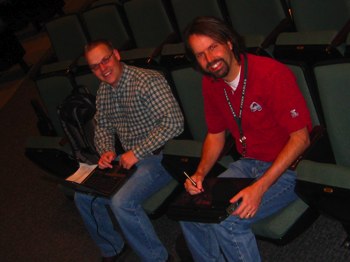 I’m especially greatful to Nancy White, the Media Services Director for the Academy District 20. We had some conversations about the roll and function of a virtual librarian for a virtual high school. Sometimes I feel like this puzzle of figuring out school 2.0 (for lack of anything else coming to mind to call it) is actually a huge egg with a really hard shell, and I just can’t penetrate that shell for answers. I look for soft places in that shell, and our conversation about what a librarian/cybrarian might do for a virtual school really felt like a soft place. Still working on that one.
I’m especially greatful to Nancy White, the Media Services Director for the Academy District 20. We had some conversations about the roll and function of a virtual librarian for a virtual high school. Sometimes I feel like this puzzle of figuring out school 2.0 (for lack of anything else coming to mind to call it) is actually a huge egg with a really hard shell, and I just can’t penetrate that shell for answers. I look for soft places in that shell, and our conversation about what a librarian/cybrarian might do for a virtual school really felt like a soft place. Still working on that one.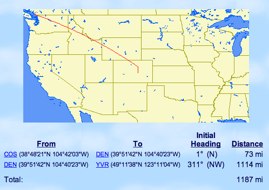 Today, I fly up to Denver and then on to Vancouver, where Ian Jukes will pick me up at the airport and take me on a tour of, what’s been described to me as one of the most beautiful cities in North America. Can’t wait, though I’m not sure my energy level will continue to stand up to the very active mind of Mr. Jukes. I’ll watch his opening keynote tomorrow morning and then will have a day to figure out how to follow him on Thursday.
Today, I fly up to Denver and then on to Vancouver, where Ian Jukes will pick me up at the airport and take me on a tour of, what’s been described to me as one of the most beautiful cities in North America. Can’t wait, though I’m not sure my energy level will continue to stand up to the very active mind of Mr. Jukes. I’ll watch his opening keynote tomorrow morning and then will have a day to figure out how to follow him on Thursday.